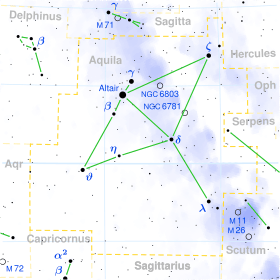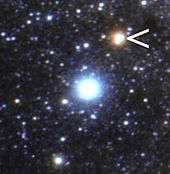Gamma Aquilae
Gamma Aquilae (γ Aquilae, abbreviated Gamma Aql, γ Aql), formally known as Tarazed /ˈtærəzɛd/,[11] is a star in the constellation of Aquila. It has an apparent visual magnitude of 2.712,[2] making it readily visible to the naked eye at night. Parallax measurements place it at a distance of 395 light-years (121 parsecs) from the Sun.[1]
 | |
| Observation data Epoch J2000 Equinox J2000 | |
|---|---|
| Constellation | Aquila |
| Right ascension | 19h 46m 15.58029s[1] |
| Declination | +10° 36′ 47.7408″[1] |
| Apparent magnitude (V) | 2.712[2] |
| Characteristics | |
| Spectral type | K3 II[3] |
| U−B color index | +1.720[2] |
| B−V color index | +1.500[2] |
| Astrometry | |
| Radial velocity (Rv) | -2.79[4] km/s |
| Proper motion (μ) | RA: +16.99[1] mas/yr Dec.: -2.98[1] mas/yr |
| Parallax (π) | 8.26 ± 0.17[1] mas |
| Distance | 395 ± 8 ly (121 ± 2 pc) |
| Absolute magnitude (MV) | −3.38+0.24 −0.22[5] |
| Details | |
| Mass | 5.66±0.66[6] M☉ |
| Radius | 95[7] R☉ |
| Luminosity | 2538[6] L☉ |
| Surface gravity (log g) | 1.63[8] cgs |
| Temperature | 4210[8] K |
| Metallicity [Fe/H] | –0.29[8] dex |
| Rotational velocity (v sin i) | 8[9] km/s |
| Other designations | |
| Database references | |
| SIMBAD | data |
Properties

Gamma Aquilae is a relatively young star with an age of about 100 million years. Nevertheless, it has reached a stage of its evolution where it has consumed the hydrogen at its core and expanded into what is termed a bright giant star, with a stellar classification of K3 II.[3] The star is now burning helium into carbon in its core. After it has finished generating energy through nuclear fusion, Gamma Aquilae will become a white dwarf.[12]
The interferometry-measured angular diameter of Gamma Aquilae is 7.271±0.073 mas,[13] which, at its estimated distance, equates to a physical radius of about 95 times the radius of the Sun.[7] With almost six times the Sun's mass, this is an enormous star that is radiating over 2500 times the luminosity of the Sun.[6] An effective temperature of 4210 K in its outer envelope gives it the orange hue typical of K-type stars.[8][14]
A 1991 catalogue of photometry reported that Gamma Aquilae showed some variation in its brightness, but this has not been confirmed.[15]
Nomenclature
γ Aquilae (Latinised to Gamma Aquilae) is the star's Bayer designation.
It bore the traditional name Tarazed,[12] which may derive from the Persian شاهين ترازو šāhin tarāzu "the beam of the scale", referring to an asterism of the Scale, Alpha, Beta and Gamma Aquilae. (Persian šāhīn means "royal falcon", "beam", and "pointer", and gave its name (as "falcon") to Beta Aquilae.) In 2016, the International Astronomical Union organized a Working Group on Star Names (WGSN)[16] to catalogue and standardize proper names for stars. The WGSN approved the name Tarazed for this star on 21 August 2016 and it is now so entered in the IAU Catalog of Star Names.[11]
In the catalogue of stars in the Calendarium of Al Achsasi Al Mouakket, this star was designated Menkib al Nesr (منكب ألنسر - mankib al-nasr), which was translated into Latin as Humerus Vulturis, meaning 'the eagle's shoulder'.[17]
In Chinese, 河鼓 (Hé Gŭ), meaning River Drum, refers to an asterism consisting of Gamma Aquilae, Beta Aquilae and Altair.[18] Consequently, the Chinese name for Gamma Aquilae itself is 河鼓三 (Hé Gŭ sān, English: the Third Star of River Drum.)[19] In Chinese mythology, The Princess and the Cowherd, this star and Beta Aquilae, are children of Niulang (牛郎, The Cowherd, Altair) and Zhinü (織女, The Princess, Vega).
The Koori people of Victoria knew Beta and Gamma Aquilae as the black swan wives of Bunjil (Altair), the wedge-tailed eagle.[20]
References
- van Leeuwen, F. (November 2007), "Validation of the new Hipparcos reduction", Astronomy and Astrophysics, 474 (2): 653–664, arXiv:0708.1752, Bibcode:2007A&A...474..653V, doi:10.1051/0004-6361:20078357
- Cousins, A. W. J. (1984), "Standardization of Broadband Photometry of Equatorial Standards", South African Astronomical Observatory Circulars, 8: 59, Bibcode:1984SAAOC...8...59C
- Morgan, W. W.; Keenan, P. C. (1973), "Spectral Classification", Annual Review of Astronomy and Astrophysics, 11 (1): 29, Bibcode:1973ARA&A..11...29M, doi:10.1146/annurev.aa.11.090173.000333
- Famaey, B.; et al. (January 2005), "Local kinematics of K and M giants from CORAVEL/Hipparcos/Tycho-2 data. Revisiting the concept of superclusters", Astronomy and Astrophysics, 430 (1): 165–186, arXiv:astro-ph/0409579, Bibcode:2005A&A...430..165F, doi:10.1051/0004-6361:20041272
- Carney, Bruce W.; et al. (March 2008), "Rotation and Macroturbulence in Metal-Poor Field Red Giant and Red Horizontal Branch Stars", The Astronomical Journal, 135 (3): 892–906, arXiv:0711.4984, Bibcode:2008AJ....135..892C, doi:10.1088/0004-6256/135/3/892
- Hohle, M. M.; Neuhäuser, R.; Schutz, B. F. (April 2010), "Masses and luminosities of O- and B-type stars and red supergiants", Astronomische Nachrichten, 331 (4): 349, arXiv:1003.2335, Bibcode:2010AN....331..349H, doi:10.1002/asna.200911355
- Lang, Kenneth R. (2006), Astrophysical formulae, Astronomy and astrophysics library, 1 (3 ed.), Birkhäuser, ISBN 978-3-540-29692-8. The radius (R*) is given by:
- McWilliam, Andrew (December 1990), "High-resolution spectroscopic survey of 671 GK giants. I - Stellar atmosphere parameters and abundances", Astrophysical Journal Supplement Series, 74: 1075–1128, Bibcode:1990ApJS...74.1075M, doi:10.1086/191527
- Bernacca, P. L.; Perinotto, M. (1970), "A catalogue of stellar rotational velocities", Contributi Osservatorio Astronomico di Padova in Asiago, 239 (1): 1, Bibcode:1970CoAsi.239....1B
- "TARAZED -- Star in double system", SIMBAD, Centre de Données astronomiques de Strasbourg, retrieved 2012-01-09
- "IAU Catalog of Star Names". Retrieved 28 July 2016.
- Kaler, James B., "TARAZED (Gamma Aquilae)", Stars, University of Illinois, retrieved 2012-01-10
- Mozurkewich, D.; et al. (November 2003), "Angular Diameters of Stars from the Mark III Optical Interferometer", The Astronomical Journal, 126 (5): 2502–2520, Bibcode:2003AJ....126.2502M, doi:10.1086/378596
- "The Colour of Stars", Australia Telescope, Outreach and Education, Commonwealth Scientific and Industrial Research Organisation, December 21, 2004, archived from the original on 2012-03-18, retrieved 2012-01-16
- Kornilov, V. G.; Volkov, I. M.; Zakharov, A. I.; Kozyreva, V. S.; Kornilova, L. N.; Krutyakov, A. N.; Krylov, A. V.; Kusakin, A. V.; Leont'Ev, S. E.; Mironov, A. V.; Moshkalev, V. G.; Pogrosheva, T. M.; Sementsov, V. N.; Khaliullin, Kh. F. (1991). "Catalogue of WBVR-magnitudes of bright stars of the northern sky". Trudy Gosudarstvennogo Astronomicheskogo Instituta. 63: 1. Bibcode:1991TrSht..63....1K.
- IAU Working Group on Star Names (WGSN), International Astronomical Union, retrieved 22 May 2016.
- Knobel, E. B. (June 1895). "Al Achsasi Al Mouakket, on a catalogue of stars in the Calendarium of Mohammad Al Achsasi Al Mouakket". Monthly Notices of the Royal Astronomical Society. 55 (8): 429. Bibcode:1895MNRAS..55..429K. doi:10.1093/mnras/55.8.429.
- (in Chinese) 中國星座神話, written by 陳久金. Published by 台灣書房出版有限公司, 2005, ISBN 978-986-7332-25-7.
- (in Chinese) 香港太空館 - 研究資源 - 亮星中英對照表 Archived August 19, 2010, at the Wayback Machine, Hong Kong Space Museum. Accessed on line November 23, 2010.
- Mudrooroo (1994). Aboriginal mythology : an A-Z spanning the history of aboriginal mythology from the earliest legends to the present day. London: HarperCollins. p. 4. ISBN 978-1-85538-306-7.